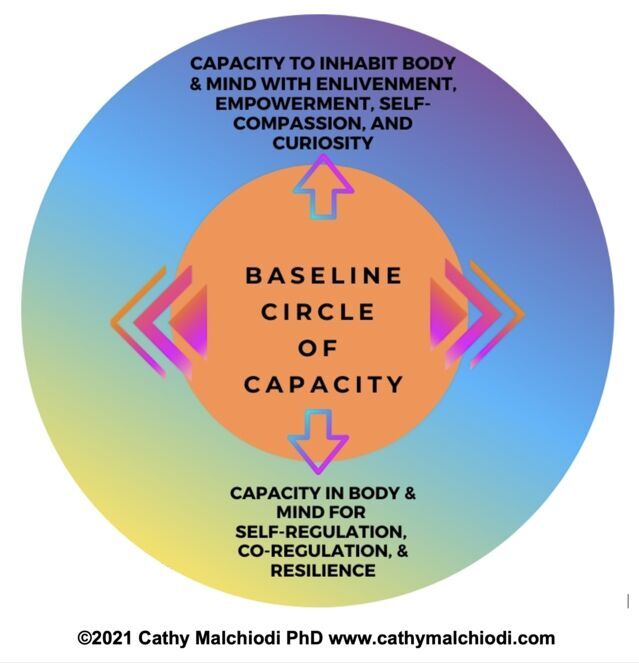
Circle of Capability Mannequin
Supply: © 2021 Cathy Malchiodi PhD
The expertise of psychological trauma is usually related to the presence of misery. However in working with trauma survivors for over three a long time, it is usually the absence of enlivenment, play, curiosity, laughter, and self-compassion. In different phrases, restore of trauma isn’t just about studying to deal with misery. Additionally it is about increasing the capability for constructive and pleasurable experiences in thoughts and physique.
Window of Tolerance
A framework generally known as “window of tolerance” is ubiquitous in trauma literature and is most frequently attributed to psychiatrist Daniel Siegel. The time period tolerance refers back to the means to endure continued subjection to one thing with out an hostile response. In line with this framework, traumatic stress decreases our window of what we’re in a position to tolerate in two common methods. We could develop into extra activated or hyperaroused and feeling overwhelmed, anxious, offended, or uncontrolled emotionally. Or we could develop into numb and withdrawn, a type of hypoarousal that may embody dissociation in response to misery.
Many people I see in my observe report each hyperarousal and hypoarousal when confronted by varied conditions and interpersonal relationships. Some report feeling each activated, but frozen and “shutdown,” underscoring that we are able to expertise each states concurrently. People with advanced trauma histories, together with a number of adverse childhood experiences, could be in each an immobilized (hypoaroused) state, but additionally really feel excessive stress, emotional reactivity, racing ideas, and hypervigilance attribute of over-activation.
The window framework is most frequently depicted via a hierarchical graphic with hypoarousal because the decrease zone and hyperactivation as the upper zone; the window of tolerance rests within the center [see this example]. Relating to traumatic stress, increasing the window of tolerance is a method of guiding medical decision-making to deal with regulation and/or dissociative responses comparable to emotional numbness and immobilization.
Circle of Capability
What if rising capability turned the dominant goal relatively than merely increasing the flexibility to tolerate distressful reactions? As an expressive and experiential practitioner, I see trauma restore and restoration via the exploration and discovery of capabilities in distinction to easily widening a window of tolerance. The self is just not essentially restored via rising the flexibility to tolerate reactions, however via supporting tangible, sensory, and somatic experiences of efficacy, resourcing, and resilience.
This can be a transformation felt within the physique because the capability for motion, empowerment, mastery, and confidence when encountering misery and disruptive occasions. In different phrases, increasing tolerance could assist a person extra successfully deal with distressing reactions. However as a way to really restore and recuperate, increasing capability entails one thing past enduring and coping. It requires figuring out and practising experiences that start to switch hyperactivation and/or hypoarousal in physique and thoughts.
The graphic under is my first try at visualizing what I name a “circle of capability.” The middle represents our baseline expertise, an space that shrinks and expands in response to a wide range of impacts together with traumatic stress. The outer circle consists of two common areas of physique/thoughts capability. One is the capability for self-regulation, co-regulation, and resilience that modulate hyperarousal and over-activation. The second is the capability to inhabit physique and thoughts via resourcing enlivenment, empowerment, self-compassion, pleasure, playfulness, and curiosity. I desire to current these two areas inside a circle relatively than a hierarchy as a result of these experiences usually are not separate, however usually overlap. Each are important in lowering the influence of traumatic stress and in supporting the restoration of the self as wholesome and entire.
Remodeling Tolerance Into Capability
Whereas I’ve utilized Siegel’s framework to my medical pondering, I’ve hardly ever defined it to people utilizing the phrase “tolerate.” Relating to the fear and atrocities of traumatic experiences, most practitioners would agree that we sadly know that trauma survivors have tolerated an excessive amount of for a lot too lengthy. In so many circumstances, they’ve coped with far an excessive amount of—abuse, neglect, and assault. Many have endured a number of traumatic occasions since childhood, together with disrupted attachment and repetitive incidents of interpersonal violence leading to tenacious emotions of shame and guilt.
Siegel’s window of tolerance mannequin will definitely proceed to be a seminal framework in trauma restore and restoration. I’m not advocating for a substitute of this framework as a approach of understanding traumatic stress. However what I’m proposing is a lane change on the subject of utilizing language that underscores capability, functionality, and empowerment inside the context of trauma-informed observe. Most practitioners are already doing this when making use of the window of tolerance mannequin. However is it time that survivors hear that restoration extends past merely increasing talents to deal with misery. It’s about instilling experiences of resilience, pleasure, and pleasure that in the end substitute struggling and ache with wholeness and well-being.
Source link













